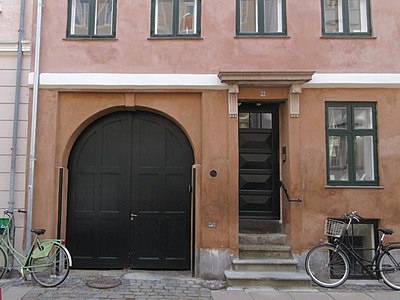
Ploug House is a listed Neoclassical property on the corner of Højbro Plads and Ved Stranden in central Copenhagen, Denmark. It dates from the building boom which followed after the Copenhagen Fire of 1795 but takes its name from the poet, publisher and politician Carl Ploug who lived there in the 1860s and 1870s and also published the newspaper Fædrelandet from the premises.

The Verrayon House is a Rococo, bourgeoisie townhouse located at Lille Strandstræde 6 in central Copenhagen, Denmark. It was listed by the Danish Heritage Agency in the Danish national registry of protected buildings in 1943.
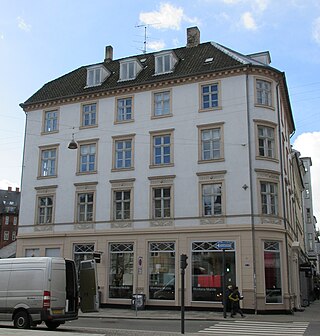
Bredgade 24 is a listed building located at the corner of Bredgade and Sankt Annæ Plads in central Copenhagen, Denmark. The building was listed on the Danish registry of protected buildings in 1987. Notable former residents include painter and photographer Niels Christian Hansen.

The Warburg House is a historic property located at the corner of Sag: Store Kirkestræde and Højbro Plads in the Old Town on Copenhagen, Denmark. The building was listed on the Danish registry of protected buildings and places in 1964. Toga Vinstue, a lunch restaurant and bar, is known as a popular meetingplace for politicians journalists and other people with an interest in politics.

Højbro Plads 15 is a Neoclassical property situated on Højbro Plads in central Copenhagen, Denmark. The building was like most of the other buildings in the area constructed as part of the rebuilding of the city following the Copenhagen Fire of 1795. It was listed in the Danish registry of protected buildings and places in 1950.
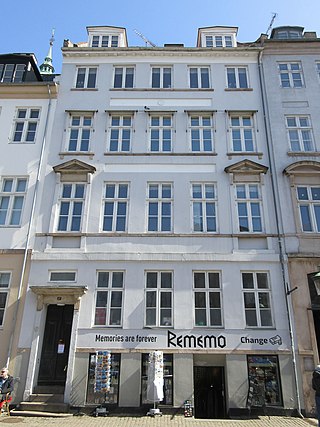
Højbro Plads 17 is a Neoclassical property situated on the east side of Højbro Plads in central Copenhagen, Denmark. The building was like most of the other buildings in the area constructed as part of the rebuilding of the city following the Copenhagen Fire of 1795. It was listed in the Danish registry of protected buildings and places in 1924.
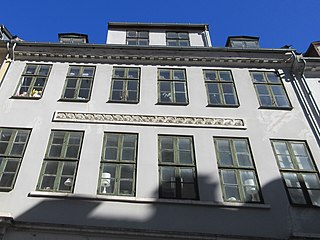
Admiralgade 19 is a Neoclassical property situated off Nikolaj Plads in central Copenhagen, Denmark. The building was like most of the other buildings in the neighborhood constructed as part of the rebuilding of the city after the Copenhagen Fire of 1795. It was listed in the Danish registry of protected buildings and places in 1945.
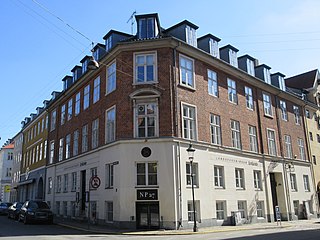
Nikolaj Plads 27 is a Neoclassical property situated at the corner of Nikolaj Plads and Admiralgade in central Copenhagen, Denmark. It was like most of the other buildings in the area constructed as part of the rebuilding of the city following the Copenhagen Fire of 1795. It was listed in the Danish registry of protected buildings and places es in 1945.
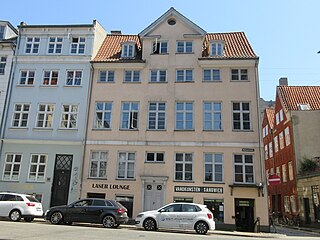
Rådhusstræde 17 is a Neoclassical property situated at the corner of Rådhusstræde and Magstræde, opposite Vandkunsten, in the Old Town of Copenhagen, Denmark. Dating from approximately 1800, it is one of the oldest buildings in the area. It was listed in the Danish registry of protected buildings and places in 1945.

Rådhusstræde 11 is an early 18th-century building on Rådhusstræde, between Gammeltorv-Nytorv and Frederiksholms Kanal, in the Old Town of Copenhagen, Denmark. It was listed in the Danish registry of protected buildings and places in 1945. The Supreme Court attorney Christian Klingberg lived in the building as a child.
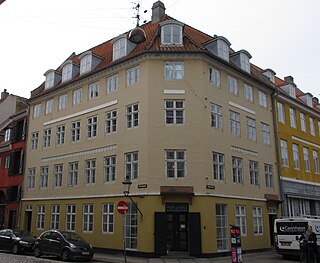
Nikolakplads 23 is a Neoclassical property situated at the corner of Nikolaj Plads and the street Nikolajgade in central Copenhagen, Denmark. It was listed in the Danish registry of protected buildings and places. The building was listed in the Danish registry of protected buildings and places in 1934. Former residents include scientific illustrator Johannes Eilert Steenfeldt, composer Rudolph Bay and playwright and theatre historian Thomas Overskou. The building is owned today by Karberghus.
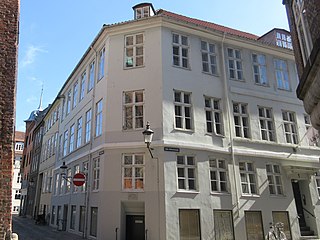
Lille Kirkestræde 1/Nikolaj Plads 28 is a Neoclassical corner building situated in front of the former St. Nicolas' Church, now Kunsthallen Nikolaj, in central Copenhagen, Denmark. It was listed in 1945. The building was like most of the buildings in the area constructed following the Copenhagen Fire of 1795. It was listed in the Danish registry of protected buildings and places in 1945.

Nikolaj Plads 32, also known as Sankt Nicolai Hus, is a property situated on the west side of Nikolaj Plads in Copenhagen, Denmark. It was, like most of the other buildings in the area, constructed as part of the rebuilding of the city following the Copenhagen Fire of 1795. It was listed in the Danish registry of protected buildings and places in 1945. Former residents include the theatrical scenic painter Christian Ferdinand Christensen.

Sankt Annæ Plads 6/Lille Strandstræde 24 is an 18th-century property situated at the corner of Sankt Annæ Plads and Lille Strandstræde, across the street from the Garrison Church, in central Copenhagen, Denmark. With its low height and a principal facade that does not face Sankt Annæ Plads, it stands out from the other buildings on the square, bearing testament to a time when the city was lower and Frederiksstaden had only just started to develop. It was listed in the Danish registry of protected buildings and places in 1950 and is now owned by Karberghus.

Amagertorv 1 is a Neoclassical property situated at the corner of Amagertorv and Højbro Plads, opposite Højbrohus, in the Old Town of Copenhagen, Denmark. Constructed in 1797 as part of the rebuilding of the city following the Copenhagen Fire of 1795, it owes its current appearance to a renovation undertaken by Christian Tybjerg in 1854. The building was listed in the Danish registry of protected buildings and places in 1989. Café Europa, a café started by fashion designer Jørgen Nørgaard in 1989, is located in the building. Notable former residents include photographer Emil Stæhr, landowner and district governor Nicolai Emanuel de Thygeson and composer and music publisher Andreas Peter Berggreen.

Kompagnistræde 24 is a Neoclassical property situated on Strædet, between Knabrostræde and R¨dhusstræde, in the Old Town of Copenhagen, Denmark. It was constructed as part of the rebuilding of the city following the Copenhagen Fire of 1795 and later heightened with one storey in 1849. The building was listed in the Danish registry of protected buildings and places in 1979. Notable former residents include the artist Janus Laurentius Ridter.

Sankt Annæ Gade 20–22 is a complex of Neoclassical buildings situated at the corner of Sankt Annæ Gade and Christianshavns Kanal in the Christianshavn neighborhood of central Copenhagen, Denmark. A distillery was for more than one hundred years—from at least the 1750s until at least the 1860s— operated on the site. The current complex consists of a corner building from 1804, flanked by two just two-bays-wide older buildings, both of which were adapted in connection with the construction of the corner building. The entire complex was jointly listed in the Danish registry of protected buildings and places in 1950. The courtyard on the rear was redesigned by landscape architect Jeppe Aagaard Andersen in the 1980s.

Krigsråd Mørks Minde, situated at Lille Kannikestræde 4, is a charity with affordable accommodation for widows and unmarried women from the higher classes in Copenhagen, Denmark, established by Emilie Henriette Mørk (Mørch) in 1864–65 in memory of her father, Claudius Mørch, who was awarded the title of krigsråd. The Neoclassical building was constructed by master mason Christian Aagaard in 1830–31. It was listed in the Danish registry of protected buildings and places in 1950. Notable former residents include actor Ludvig Phister, cookbook writer Anne Marie Mangor, painter Emil Carlsen and Professor Nicolai Christopher Kall Rasmussen.
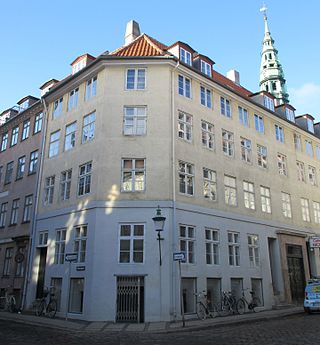
Nikolajgade 20 / Dybensgade 20 is a Neoclassical apartment building situated at the corner of Nikolajgade and Dybensgade in central Copenhagen, Denmark. The building was constructed by master mason Anthon Christian Wilcken and master carpenter Andreas Hallander in 1799–1800 as part of the rebuilding of the city following the Copenhagen Fire of 1795. It was listed on the Danish registry of protected buildings and places in 1959. A young Hans Christian Andersen was the lodger of a widow on the second floor in the early 1820s. From 1825 to 1840 the building was operated as a home for indigent seamen under the name Bombebøssen. That institution—founded by the naval officer Peter Norden Sølling in 1819—was then moved to Christianshavn. The building at the corner of Nikolajgade and Dybensgade was hit by fire in 1855 but subsequently restored.

Toldbodgade 9 is a half-timbered building situated in the Nyhavn Quarter of central Copenhagen, Denmark. For about 50 years, from the 1800s until his death in 1852, the property belonged to Henning Hansen Rønne, a skipper from Bornholm, who for a period was alderman of the Skipper's Guild in Copenhagen. The building was later for a while operated as a hotel under the name Hotel Helsingborg. The building was listed in the Danish registry of protected buildings and places in 1918. In 1953, the building was bought by art dealer Viggo Clausen, who subsequently converted it into an art gallery under the name Claussens Kunsthandel. In 2018, Claussens Kunsthandel relocated to new premises at Studiestræde 14. A restaurant administration is now located in the building.



